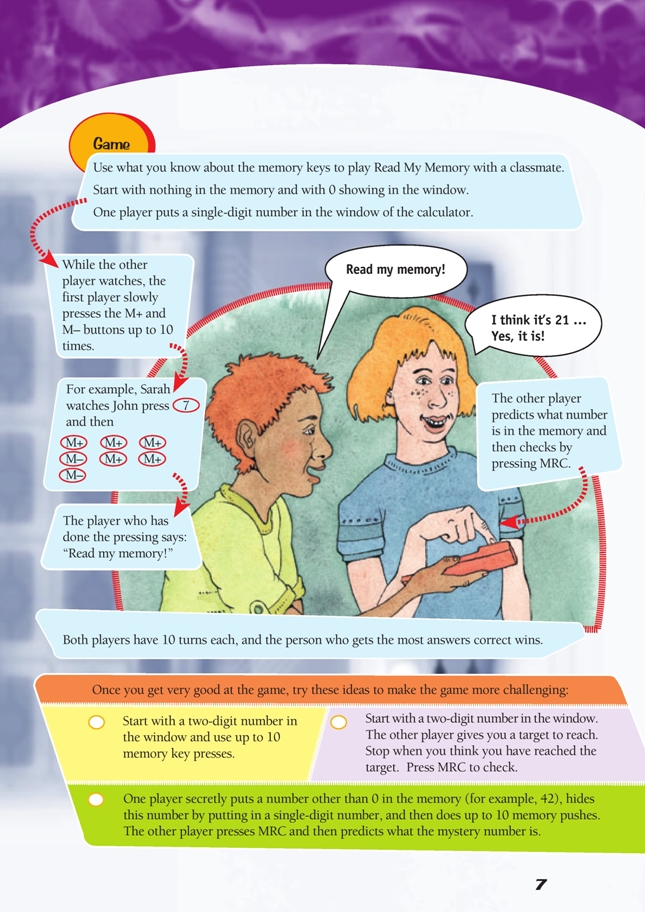This is a level 2 number activity from the Figure It Out series. It relates to Stage 5 of the Number Framework.
A PDF of the student activity is included.
Click on the image to enlarge it. Click again to close. Download PDF (365 KB)
practise mental addition and subtraction strategies
FIO, Levels 3-4, Basic Facts, Memory Testing, pages 6-7
classmate
The calculator is an excellent tool to help students to check mental calculations and hence to improve number sense. The advantages of using a calculator in this activity include the student being able to visualise the arithmetic leading to the unseen cumulative total. A calculator also provides quick feedback to the student’s responses. Many calculator users do not make good use of the memory functions on their calculator, so here is a good opportunity for the students to learn how to use this function.
The following is a practical example of the use of the memory function. The first step is to clear the memory.
Two bottles of milk at $2.95 each: 2 x 2.95 = M+
Three loaves of bread at $1.45 each: 3 x 1.45 = M+
Two cans of baked beans at $1.15 each: 2 x 1.15 = M+
Total for list: MRC
Learning to use the memory function may take time and practice. Different brands of calculators may have slightly different memory keys or functions, so the students may need to experiment with their calculators. It may be worthwhile to get the students to record the steps they followed when they used their calculators.
The students need to make sure that they clear the memory before beginning a new game.
A useful teaching strategy is to use an overhead projector calculator to play some games with the class or group and also to ask the students to play a game in pairs on the overhead projector as a demonstration. (Make sure you do not leave the calculator on the projector when you are not using it.) For example, ask the students to raise their hands when they think the total in the memory has reached 100. When over half the class thinks this has happened, press MRC.
Game
This game provides students with an opportunity to practise mental addition and subtraction. They will need to take care not to push the buttons too fast.
The students can repeat the game, in its basic or more challenging forms, several times as a warmup activity or in spare classroom moments.
In order to play the more challenging versions of the game suggested at the bottom of the page, the students will need mental strategies to add and subtract two-digit numbers. Reflecting and discussing are good ways of sharing efficient strategies. Ask: “What did you say in your head when you added 26 each time?”
Possibilities include: adding 20 and then adding 6, or adding 30 and then subtracting 4.
As a variation, play target games using only single-digit numbers. For example:
Two players choose a target number, for example, 50. Then they take turns to enter alternate single-digit numbers (zero is not allowed), followed by M+. When a player thinks that the target will be hit in their next turn, they enter their number and M+ and then MRC to check whether they are right. If they are right, they win the game. Target numbers can be varied and the difficulty level altered quite easily.
The students can also play this game using subtraction, this time beginning from the higher number to reach the target, zero.
As an extension, challenge the students to make up a list of items for a party. For example, six bottles of coke at $2.25 each, five bags of chips at $1.75 each, seven chocolate bars at 90 cents each, and so on. The students estimate the sum mentally by rounding and then calculate using the calculator memory.
Answers to Activity
1. a. 24 is in the memory. Pressing M+ three times puts in 8 + 8 + 8. 3 x 8 = 24
b. M shows that something is in the memory.
2. 0 is in the memory. It is the same as
9 + 9 + 9 – 9 – 9 – 9 = 0.
(3 x 9) – (3 x 9) = 0
Game
A game using calculator memory

